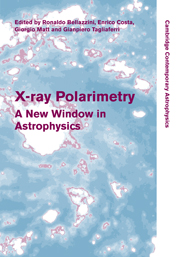Book contents
- Frontmatter
- Contents
- List of contributors
- Preface
- 1 X-ray polarimetry: historical remarks and other considerations
- Part I Polarimetry techniques
- Part II Polarized emission in X-ray sources
- 14 Probing strong gravity effects with X-ray polarimetry
- 15 X-ray polarization from black holes in the thermal state
- 16 Strong-gravity effects acting on polarization from orbiting spots
- 17 Polarization of thermal emission from accreting black holes
- 18 X-ray polarimetry and radio-quiet AGN
- 19 The soft X-ray polarization in obscured AGN
- 20 The polarization of complex X-ray sources
- 21 Polarization of Compton X-rays from jets in AGN
- 22 Polarization of X-ray lines from galaxy clusters and elliptical galaxies
- 23 Polarization characteristics of rotation-powered pulsars
- 24 Polarized X-rays from magnetized neutron stars
- 25 Polarization properties of X-ray millisecond pulsars
- 26 X-ray polarization signatures of neutron stars
- 27 Polarization from the oscillating magnetized accretion torus
- 28 X-ray polarization from accreting white dwarfs and associated systems
- 29 Polarization of pulsar wind nebulae
- 30 X-ray polarization of gamma-ray bursts
- 31 Central engine afterglow from GRBs and the polarization signature
- 32 GRB afterglow polarimetry past, present and future
- 33 Gamma-ray polarimetry with SPI
- 34 INTEGRAL/IBIS observations of the Crab nebula and GRB 041219A polarization
- 35 Fermi results on the origin of high-energy emission in pulsars
- 36 Diagnostics of the evolution of spiral galaxies in a cluster environment
- Part III Future missions
- Author index
- Subject index
20 - The polarization of complex X-ray sources
from Part II - Polarized emission in X-ray sources
Published online by Cambridge University Press: 06 July 2010
- Frontmatter
- Contents
- List of contributors
- Preface
- 1 X-ray polarimetry: historical remarks and other considerations
- Part I Polarimetry techniques
- Part II Polarized emission in X-ray sources
- 14 Probing strong gravity effects with X-ray polarimetry
- 15 X-ray polarization from black holes in the thermal state
- 16 Strong-gravity effects acting on polarization from orbiting spots
- 17 Polarization of thermal emission from accreting black holes
- 18 X-ray polarimetry and radio-quiet AGN
- 19 The soft X-ray polarization in obscured AGN
- 20 The polarization of complex X-ray sources
- 21 Polarization of Compton X-rays from jets in AGN
- 22 Polarization of X-ray lines from galaxy clusters and elliptical galaxies
- 23 Polarization characteristics of rotation-powered pulsars
- 24 Polarized X-rays from magnetized neutron stars
- 25 Polarization properties of X-ray millisecond pulsars
- 26 X-ray polarization signatures of neutron stars
- 27 Polarization from the oscillating magnetized accretion torus
- 28 X-ray polarization from accreting white dwarfs and associated systems
- 29 Polarization of pulsar wind nebulae
- 30 X-ray polarization of gamma-ray bursts
- 31 Central engine afterglow from GRBs and the polarization signature
- 32 GRB afterglow polarimetry past, present and future
- 33 Gamma-ray polarimetry with SPI
- 34 INTEGRAL/IBIS observations of the Crab nebula and GRB 041219A polarization
- 35 Fermi results on the origin of high-energy emission in pulsars
- 36 Diagnostics of the evolution of spiral galaxies in a cluster environment
- Part III Future missions
- Author index
- Subject index
Summary
The radiative transfer code STOKES was extended to allow for X-ray polarimetry modelling. The physical mechanisms of Compton scattering, photo-absorption, and the production of iron K lines were added and are illustrated by modelling the X-ray polarization spectrum of irradiated, cold matter disks. These models confirm that the orientation of the polarization position angle is related to the size of the disk. Although strongly diminishing the spectral flux, an obscuring torus around a small irradiated disk significantly increases the polarization at intermediate viewing angles. Our modelling shows that the polarization can be very sensitive to the radiative coupling between different reprocessing regions.
Introduction
Polarimetry and spectropolarimetry are an important extension of photometry and spectroscopy techniques. In addition to the spectral intensity, i.e. the first Stokes parameter, the linear polarization percentage, P, and position angle, ψ, can provide further information about the geometry and the dynamics of a given object. To decode this information, accurate modelling is necessary. For this purpose I started the development of the radiative transfer code STOKES that is based on the Monte-Carlo method and that computes the polarization spectrum due to multiple photon-matter interactions in geometrically complex environments. The code is publicly available on the web. New versions of STOKES will be subsequently provided for download after they have been carefully tested and documented. The code has recently been extended to include polarization effects that are relevant in the X-ray range.
- Type
- Chapter
- Information
- X-ray PolarimetryA New Window in Astrophysics, pp. 136 - 141Publisher: Cambridge University PressPrint publication year: 2010
- 2
- Cited by

